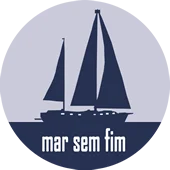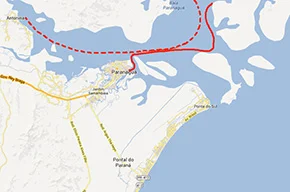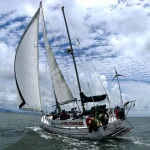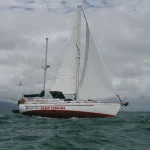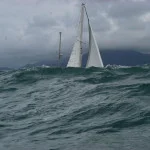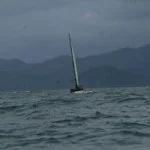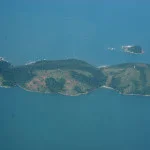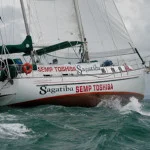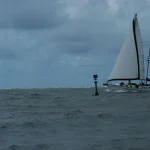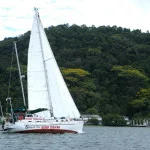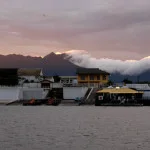Saturday, 04 – 11 – 2006.
It was about 2 p.m. when I stopped at “Buraco Quente” (Hot hole) Bar, in Pariquera-Açu, a few kilometers from Cananeia. I’ve been dreaming for quite a long time to have the opportunity of eating again the minced meat sandwich which made the bar known and named it. It’s been the same quality for years. It was a good idea to stop at the bar. As usual, the sandwich is delicious, succulent, with a sauce made with onions, tomatoes and tiny pieces of Calabrian sausage. And then a juicy portion is put in a soft crust roll from which the inside was removed so that the filling is put in. You eat it with a knife and fork. It is very tasty.
We went to Cananeia after lunch, to the nautical center where the Endless Sea and our new support boat were; a powerful 17 foott inflatable with a 115 horsepower stern motor, perfect for our trips. We will have to cross a significant part of the lagoon. The inflatable can take us where the sailboat can’t. Additionally, its high speed allows us to cross several rivers in a short period of time.
As usual, Alonso had already met lots of people when we arrived. The same pilot who had taken us to Paranagua six years ago asked us if we needed his help again.
It is better when everything is rapidly solved.
Sunday, 5 – 11 – 2006.
On the second day, we had planned to go to Bom Abrigo Island to shoot “our arrival”, the island and sail a little. It’s been a long time since we last sailed, that is when we returned from Abrolhos. We have been using the motor since then. There is either too much wind due to cold fronts or nothing at all. There is no midway point which is perfect for a boat like the Endless Sea.
Early in the morning we sailed towards the bar. Ships cannot enter any more like in the past; only fishing boats and sailboats. The lowest part is more than 4 meters deep and today, fortunately, you even see buoys delimiting the entrance.
Tonight there was strong wind; Joselia Pegorim (our meteorologist) had already forecasted it. In the canal where we were the southeast wind reached 26, 28 knots. This morning it was still blowing hard, from 20 to 22 knots. Consequently, the waves were quite big between 2 meters and 2.50 meters high.
Now with the support boat we can shoot the Endless Sea sailing more often. This was impossible with the small rubber boat. We spent our morning luffing, with foul and crosswise winds. Eventually, we entered in the bar going down the waves and sailing. It was so beautiful that people in a fishing boat which was passing by clapped when they saw us.
We returned to the nautical center at the beginning of the afternoon. We had enough time to shoot the settlement as well as the beautiful church at the central square.
Everybody knows us here. While I was taking pictures, several kids and adults came and talked to me to congratulate us or wish a good stay in Cananeia. Later on I met Paulina who was also surprised. Many people stopped us in the streets to ask about the TV program.
It took us an hour to register the center. We decided to go to the city’s most famous bar whose owner is João Rios. He is an expert in preparing white rum with fruits, roots and leaves. I also saw at the hall of a hotel a miniature of a baleeira (a fishing boat whose shape is similar to a whaleboat), one of the traditional models from the South of the country. I got in the hotel and asked who the craftsman was. Right after that I bought one for my collection.
I was very happy and went to Seu João Rios’ bar to celebrate. We drank a lot of cachaça (white rum) in the evening; I drank it with guava, Paulina and Cardozo with cataia, a leave.
Monday, 06 – 11 – 2006.
At 9:30 a.m. we were at Ceagesp’s pier waiting for fisherman Pedro who would take us to his fishing area. While we were waiting, we registered images of a big fishing boat being unloaded; the same boat we had seen enter in the bar. It was full of fishes and the crew was busy unloading it. A big basket was thrown in the basement and was immediately lifted full of fishes. And then the fishes were removed from the upper deck to the warehouse.
Paulina conducted an interview.
When we were about to finish, we saw Pedro leave with his baleeira. We followed him. It didn’t take more than 15 minutes; we had enough time to cross the canal and sail a little towards the exit of the bar. Soon his fishing area was right in front of us. Pedro told us that his father had spent the night there to avoid the action of biguas, a wild duck.
First, he dives to be sure there isn’t any hole in the submerged part. And then he comes up through the sideways up to the point he can throw a net to the bottom. Pedro and his assistant started to pull afterwards. Right away a huge number of fishes show up jumping and fighting for room. There were more than 200 kilos of fish.
Recording the whole process was wonderful. Especially due to the fact that Pedro has a unique assistant: a gray boto he has known for 13 years “since it was a youngster”. This animal helps him by encircling the area and confining the fish towards the trap so that it enters in the labyrinth of walls and is caught. On the other hand, every day when he throws the trawl-net, he chooses succulent paratis which are given to his “friend” like someone who has a pet dog. They just skipped the caressing and the tail wagging part.
We recorded everything. We interviewed Pedro and returned to Cananeia. The next step was to talk to the director (since 1997) of the Cardoso Island State Park, oceanographer Marcos Bürer Campolim.
Meeting him was a great pleasure to me. Marcos knows the area and the economic cycles deeply. And he makes wonders in the area of the Park.
He told us that in the last century there were more people on the Cardoso Island than in Cananeia. When the port was ruined, the outflow of the rural production was difficult. Thus the migration from the island to the continent started. Agriculture also decayed; consequently, the non-industrial fishing cycle was born and it remained the most important activity until the seventies when the first and evident decreasing signs became visible. And then came tourism, which is the main activity today.
After these historical changes, came the limiting legislation of the parks which made the traditional population, who resisted on the Cardoso Island, move faster.
According to my comments on the last logbook, I asked him about his opinion on the Brazilian model which limits almost all types of activities for those who live in its perimeter. Marcos agreed and explained that in Brazil there are two environmentalist groups: preservationists who believe everything is forbidden; socio-environmentalists who are against the toughest determinations. He also disagrees with the prohibition of the traditional population’s activities. He thinks they are the best guardians of their areas and told us that until 2000 the legislation of the Conservation Units in Brazil was not clear in regard to the presence of the traditional communities.
According to him, the major progress was possible this year with the legislation that followed the existence of the “SNUCs”, National System of Conservation Units. For the first time, this system admitted that the traditional communities didn’t necessarily have to leave a protected area. It is also stated that the government authorities must be in charge of the removal of the indigenous peoples, if it is the case, and it assures they can stay and keep their traditional activities, if they want so.
Marcos admits that the first model adopted in Brazil came from the United States in the 40s; when Yellowstone was created with very limiting determinations. He thinks that “it was a necessary evil”. This model helped to “protect Jureia”, as well as other areas, “however, today, the administrators (of the units) and the academic community evolved”. When I mentioned Dauro’s statements on the situation, the fisherman who had left Jureia (previous logbook); he said that it was a “management failure”. Marcos mentioned one more time the SNUC legislation and said that a Committee has been compulsorily required since then. “In the past, the administrator was the boss”. Now an Advisory Committee is required in the Full Protection Units. The Sustainable Use Units require a Deliberative Committee. In both cases, natives have a seat.”
I asked which activities were allowed. Marcos explained to us that all of them “even cutting trees to make canoes” as long as they obey certain rules and use them for themselves.” Small plantations, renovating their houses, building new rooms for tourists, etc. All this is clearly made, discussed by the Committee with the participation of the main protagonists and without benefiting previously one of the sides. In regard to the Cardoso Island State Park, the Committee was mounted in 1988 and it has operated regularly since then. There are two meetings every month. One of these meetings will be held during our visit. People are naturally encouraged to participate and they do participate.
Looking at this natural scenery which I had the opportunity to see in the 60s, when I used to come to my father’s house, in Cubatão Port, I think I finally found one more good example. Apparently, very little has changed; just the fact that this huge animal, vegetal and cultural biodiversity is now “guaranteed by laws” and that at least in this case, the inspectors are alert, diligent, serious and conscious. And their model of protected area is successful.
When Marcos was asked about the major threats, I was astonished at the frankness. “Hunting, a cultural issue for this people, and the palmetto extraction; they both result from the lack of economic alternative.”
In addition to these problems caused by local inhabitants, there are those from the outside. One of the most common is the crab collection in the mangrove, trawl-nets on the coast and the use of gerivau, a sort of small trawl-net used to capture shrimps. Today they are pulled by cars! Finally, he mentioned another net which is sometimes put by natives in the mouth of the rivers.
Another typical problem is the increasing number of encircled fishing areas. Since the area is monitored by satellite photos, it is easy to determine the increase which results from the action of people from the outside. They are destroyed afterwards. Houses built in irregular areas of the Park are also destroyed.
After this excellent interview, we went to Maruja with Selmo in the inflatable boat, a guide suggested by him. We returned to the sailboat at the end of the day.
Tuesday, 07 – 11 – 2006.
Today we are going to Iguape. I asked the crew to help me to talk to Mr. Nishidate. I bought one type of canoe and got a different one. I had to change it. Paulina and Cardozo came with me. It was a difficult task, but we eventually convinced the owner. Tomorrow, the truck will change it.
We returned to Cananeia at 3 p.m. My friend, Plinio Romeiro, was already on board waiting for us and had plenty of orders to give. He is one of the most perfect “nautical beings” I have ever met. However, when he gets on the Endless Sea, sometimes he looks crazy and this nervous tic makes him give lots of orders indistinctly and uninterruptedly. People reacted and before the end of the trip we called him Sergeant Tainha. Revenge never fails, that’s what the popular proverb says…
Plinio had already helped us on our trip to Ilhabela. He will participate on this trip too. Pilot Catraca embarked with him too.
We set sail and left.
We will sleep in Maruja tonight.
Wednesday, 08 – 11 – 2006.
This morning we had the opportunity to confirm the information of the director of the Park. We talked to one of Maruja’s most remarkable citizens; a fishermen’s natural leader, Seu Ezequiel.
He gave us the most idyllic image of the situation. Most villages’ people take part in the Committee’s decisions. Until 1997, when there was no management plan “everything was forbidden; in spite of that people disobeyed and the government authorities pretended they didn’t know anything.” During this period, the fishermen organized themselves. They created different tourism rules and when the management plan was ready, they submitted it for their appreciation. “The coordinator liked the idea and put it in the management plan.”
From that moment on they found out there was a new legislation ruling the area, prohibiting speculation which could help them. They started to study it in spite of the fact of being against their nature, that is, more intuitive, according to Seu Ezequiel, and were able to make good use of it. The monthly meetings encourage them to do so. Conflicts decreased and they reached the desired self-sustainability; their culture and way of life are preserved. What else do they want? Isn’t it the best world? Is there any poverty?
Of course, there is. These people are humble and live with a little bit more than the necessary minimum. There is no hunger and there is dignity. It’s something and it is the best we have seen so far in regard to traditional populations.
Seu Ezequiel told us that he knew the north coast. He saw what happened to Toque-toque’s populations as well as those from other beaches: slums. He didn’t want the same destiny for his people. He had to fight. He complains saying that it was not easy to abandon nature’s cycle when the only necessary thing to do was to observe the tides or winds. And then they had to act in accordance with the NGOs’ determination. Today they can benefit from that.
I also asked him to tell me about the period during which the Varadouro Canal was opened. He accepted it easily. He said that Ararapira was the area’s greatest city “with many stores and it was even bigger than Cananeia”. Today, it is merely a desert village on the border between Sao Paulo and Parana.
When the canal was opened in 1954, “the erosion process which was already strong was worse and people left”.
At that time, people didn’t know exactly to which state the district belonged. When finally in the 50s, a political process was established and the future of Ararapira was decided in the congress: the village and the entire island of Superagui was then part of the state of Parana.
After the interview, we continued sailing.
We stopped in front of Ararapira to take pictures and shoot; and then we continued our journey until the village of Ariri. We anchored and waited for an hour until the full tide. Afterwards, we started to sail again and went to the Pinheiros Island in the bay which has the same name and where we would spend the night.
The pilot said goodbye and returned to Cananeia in his canoe. We made dinner and heard the noise of purple face parrots which are threatened with extinction and are habitants of this island.
After that we had dinner and went to bed.
Thursday, 09 – 11 – 2006.
Tonight I was thinking about the Cardoso Island State Park and its successful way of preserving biodiversity and the presence of fishermen who live in the Park. This is different from other Parks where natives are ignored or practically expelled or prohibited from living from their centennial activities. I remember the talk we had with USP’s professor, anthropologist Antonio Carlos Diegues, who wrote many books and carried out many studies on fishermen. According to Diegues, the Cardoso Island Park is an example in terms of administration. “One of the best in Brazil”, that’s what he said.
When I asked his opinion on the program that requires the exclusion of traditional populations, he repeated more or less what the Park’s current head had said, that is, it was a necessary evil. The professor believes that if the Jureia Park didn’t exist “the fishermen who live there wouldn’t exist either”.
In view of my nonconformity in regard to the program, Diegues gave me the article by Mark Dowie, an American writer, he had asked to translate. The article was published in Orion Magazine, in January 2006. The title is “Conservation Refugees”. Dowie is a professor in the post-graduate course of Berkley University’s School of Journalism.
I read the article many times and started to understand from where the trend comes.
Among other things, Dowie explains that millions of native populations were expelled from their lands which were then occupied by big oil companies, mines, logging and mono cultures. However, today the list of the institutions which destroy cultures and are accused by tribe leaders in practically all the continents includes surprising names such as Conservation International (CI), Nature Conservancy (TNC), World Fund for Wild Life (WWF) and Wildlife Conservation Society (WCS). The author tells that in 2004, a United Nations’ meeting was held in New York to “approve a resolution protecting the human and territorial rights of the indigenous populations.”
Later, during the same year, in Vancouver, Canada, in a meeting of the International Forum on Indigenous Mapping, all the 200 delegates signed a declaration stating that “the activities of the conservation organization now represent the single threat to the integrity of indigenous lands”.
In his study he says “curious about this brand of conservation that puts the rights of nature before the rights of people, I sat out to meet the issue face to face.” And then he traveled to Africa, Asia and South America to see in loco the situation of the various reserves.
Here is what he found: Financial support for international conservation has expanded in recent years and today it includes very large foundations like Ford, MacArthur, Gordon and Betty Moore, as well as the World Bank, USAID, a host of bilateral and multilateral banks and big transnational corporations”
During the 90s, USAID alone pumped 300 million dollars into the international conservation movement and the five biggest NGOs, CI, TNC and WWF absorbed 70% of that expenditure whereas indigenous communities received none.”
Additionally: “The Moore Foundation made a ten-year commitment of nearly 280 million dollars, the biggest environmental donation in history to just one NGO, Conservation International; all of the BINGOs (Big International NGOs) have become increasingly corporate in recent years, both in orientation and affiliation.”
According to the author, ”with this type of financial and political leverage, the NGOs have undertaken a hugely expanded global push to increase the number of so-called protected areas all over the world”.
“In 1962, there were about a thousand protected areas, but today there are about 108.000.” He also said: “Currently, 11.75 million square miles are protected, an area bigger than Africa’s total surface.” The sensational discovery is the fact that in spite of this or because of this in addition to the model I don’t like “the UN and the anthropologists’ estimates range from 5 to 10 million conservation refugees.” Is it possible? We must say that these people think that live and protected animals are more important than people!
I was astonished when I heard these figures. It is still hard to believe and accept it.
Next Dowie shows the ideas of a few “titans” of the world’s conservation. WWF’s president, Steven Sanderson stated: “The entire global conservation has been “hijacked” by advocates for the cause of indigenous peoples, placing animal life and biodiversity in peril.” He also declared that “Forest peoples and their representatives may speak for the forest, but they don’t speak for the forest we want to conserve.” Am I wrong or he is a bit arrogant?
Dan Campbell, TNC’s director in Belize, declared: “we have an organization that tries sometimes to use models which don’t fit into the culture of the countries where we work.”
There are other declarations which are as bombastic as or more than these. One of them was declared by John Terborgh from Duke University: “I think that a park must be a park and nobody can live in it.” At the end of the study there is a last declaration by paleontologist Richard Leakey, announced in South Africa, during an environmentalist congress in 2003. Fortunately, the declaration “resulted in a series of protests” since the author, who is African, denied the existence of native populations in Kenya and he ended saying that “global interests in regard to diversity shall sometimes be beyond local communities.”
In his article, Mark Dowie insinuates that behind this type of idea there are the interests of the corporations, especially those who support environmentalists. Here is the full transcription: “Particularly problematic is the fact that international conservation organizations remain comfortable working with some of the most aggressive corporations which use global resources such as Boise Cascade, Chevron-Texaco, Mitsubishi, Conoco-Philips, International Paper, Rio Tinto Mine, Shell and Weyerhauser, all of them are members of a CI-created entity called the Center for Environmental Leadership in Business. Of course, if the BINGOs (big international NGOs) were to renounce their corporate partners, they would forfeit millions of dollars in revenue and access to global power without which they sincerely believe they could not be effective.”
However, Dowie ends with an encouraging paragraph. Let’s see it: “More and more conservationists seem to be wondering how, after setting aside a “protected” land mass the size of Africa, global diversity continues to decline. Might there be something terribly wrong with this plan, particularly after the Convention on Biological Diversity has documented the astounding fact that, in Africa, where so many parks and reserves have been created and where indigenous evictions run highest, 90% of biodiversity lies outside of protected areas? If we want to preserve biodiversity in the far reaches of the globe, often occupied by indigenous people living in ways that are ecologically sustainable, history is showing us that the dumbest thing we can do is kick them out.”
Let’s hope this bias wins among all those concerned about the environment.
Well, we spent our day visiting the community of Superagui, not far from here.
And then we lifted anchor and sailed to the next community, Tibicanga village. Like the previous one, it is a small settlement where fishermen still live from extraction. The area has a unique beauty and biodiversity is extraordinary. We grounded twice on our way and were successful thanks to the inflatable boat. The procedure is interesting and it is worth describing it. The inflatable boat pulls the halyard of the great sail which is attached to the main mast of the Endless Sea at an angle of 90 degrees in regard to the prow. This makes the sailboat “lay aside” and this maneuver makes the keel leave the mud.
We anchored in front of Tibicanga on the banks of the Peças Island where we spent the night.
We are near the bay of Paranagua. Tomorrow we are going to cross it to reach the city which has the same name, in the state of Parana.
This is the fifteenth coastal state we will have visited. There are just two left: Santa Catarina and the last one, Rio Grande do Sul.
Plinio is at the plotting table where I usually write and with sarcasm he asks me how he shall be dressed tonight…
Paulina is having a shower. Cardozo and Alonso are trying to turn the TV on to watch a soap opera episode.
We will continue tomorrow.
Friday, 10 – 11- 2006.
Early in the morning we were in the inflatable boat and went to Guaraqueçaba. To reach it, we must cross the bay of Laranjeiras and sail towards the west until the back of the bay where the small town is.
Guaraqueçaba is a lost place which can be reached almost exclusively by sea. If you come by car, you have to take a very bad “unpaved road” in Antonina. Since it is difficult to reach it, it is quite isolated. On our way, we noticed that in spite of the 70s and 80s’ speculation hardly attacked by the press, especially by O Estado de S.Paulo and Jornal da Tarde, during successive campaigns with environmentalists, and the buffalo breeding that reigns in the area; when you come from the sea, it seems intact. The Atlantic Forest surrounds the bay and neighboring hills.
The number and the beauty of the canoes also called my attention. Not only those having the stern and prow round, inherited from the Indians, but also those with a sharp and elongated prow and straight stern. They are similar to those I saw, described and which I took pictures of in Iguape and Cananeia. Seu Ezequiel told me they are from Santa Catarina. These canoes have a high and elongated prow due to the fact of going to the sea and facing high waves which break. In general, they are very big and colorful as usual and extremely fast with their center motors.
There are plenty of them at Guaraqueçaba port.
We walked around the city, ate a delicious crab, the best I have tasted so far on this journey; at Barbosa’s bar in the city’s central square.
And then we returned to the Endless Sea. We had to arrive in Paranagua with day light.
We lifted anchor and started sailing. This time we didn’t have any problems. No sandbank on our way.
At the end of the day we anchored at Paranagua Yacht Club.
Saturday, 11 – 11 – 2006.
We will spend the day visiting Paranagua port, which is very important for the outflow of soy from the center-west, and the city of Antonina, in the back of the bay of Paranagua.
When we passed the boats at the port, two things called our attention. First, some sort of smoke covering them. The huge ship was being loaded and when we arrived closer we felt the unmistakable smell of soy husk.
It was a phantom like image, that huge thing covered by thick clouds of soy “dust”.
The second thing was to see it discharge ballast water in the middle of the port without any inspection. As I have already said in previous logbooks, the danger of bioinvasion is the second worst problem causing biodiversity decrease in the planet.
In spite of this fact, the international community has not yet reached a solution.
We sailed for half an hour in the inflatable boat until we arrived in Antonina. On our way we passed Petrobras’ refinery which sometimes damages the mangroves of the area as well as the water of the estuary with oil leakage. This is the reason why Petrobras supports and sponsors several protection programs for the environment such as Tamar Project and Peixe-Boi Project among others. Petrobras knows that the activity of the company is dangerous and it frequently damages the environment. That’s the reason why, the company also develops activities that protect and try to guarantee our biodiversity. Thank goodness!
In the past, Antonina was an important port of the Southeast of Brazil. Huge sailboats used to come to the port. Joshua Slocum, one of the icons of the world sail, shipwrecked here, in 1887. A sandbank made him loose his ship, a clipper called Aquidneck. With it Slocum also lost almost all the money he had. His wife and two sons as well as other people were on board. Out of this adverse situation he made history and wrote one of the most beautiful chapters of the world navigation.
He simply decided to build a boat similar to the Brazilian canoes which he admired so much, armed like oriental sampans. The small sailboat of 35 feet was made of wood chosen by Slocum himself in the Atlantic forest and the sails were sewn by his wife. The boat was launched in the sea on May 13, 1888 and that’s why it was called Liberdade, in Portuguese (Liberty). After sailing for 55 days, he returned to his homeland, the United States. A great adventure!
Antonina is a charming city. The beautiful colonial settlement is preserved. Special emphasis must be given to the fantastic district theater. The size and its imposing aspect shows its past magnitude.
We shot and took pictures. Afterwards we had lunch in one of the best restaurants we have been so far: “Caçarola do Joca”, on the main square and the owner is Joca, from São Paulo. We tasted the famous Barreado, a typical local dish. It was simply delicious.
At the end of the day, we were at Paranagua Yacht Club.
We will return to São Paulo tomorrow by Curitiba. We will go up Graciosa mountain by train and arrive in the capital of the state and from there we will go to São Paulo.
On our next trip, we will go to Ilha do Mel and Guaratuba.
